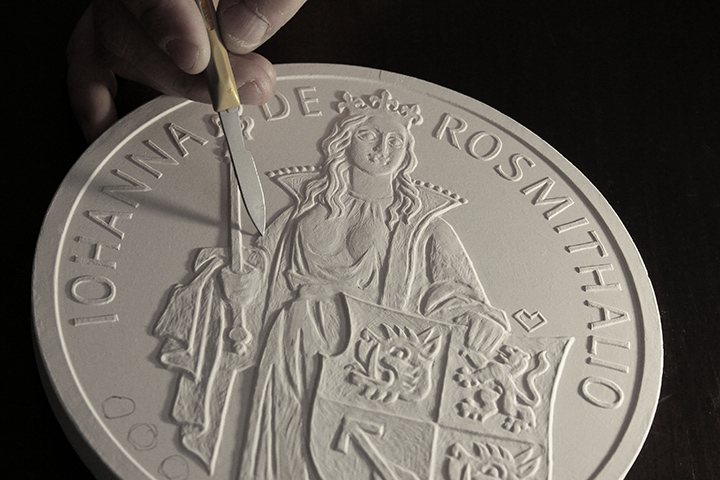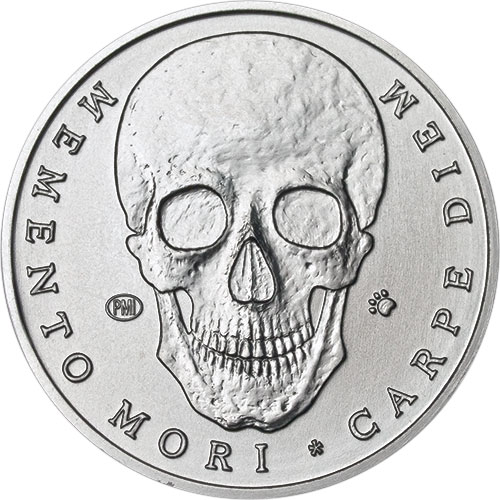Free Info To Drawing Prague Mint Medals
Wiki Article
How Is The Plaster Model Converted Into A Digital 3d Model For Gold-Plated Coins Or Medals?
The process involves scanning a maquette to create a 3D digital representation of gold coins or medals. Specialized equipment is used to capture the information and dimensions of the physical model in digital format. The digital reproduction is used to serve a variety of purposes during the manufacturing process.
3D Scanning Technology - High-resolution 3D scanners are used to capture the physical dimensions and specifics of the model. These scanners use various methods including laser scanning or structured light to record precise measurements and geometrical details.
Surface Information Capture- The scanner emits laser or light beams at the plaster model's surface. The scanner tracks the distortions and reflections these beams cause, taking in surface information.
Data Collection- As the scanner travels across the surface of the plaster model, it collects an enormous amount of data points, resulting in an electronic representation of the model's geometry including contours, details, and contours.
Conversion into 3D Model: The data points are recreated using specialized software. The model is a replica of the physical dimensions and features of the maquette of plaster.
There are a variety of reasons to make an 3D digital model
Digital 3D models permit exact reproduction of the physical model's dimensions and specifics. This accuracy is crucial to ensure that the final gold medals or coins are in line with the appearance.
Digital models can be easily altered and improved. Designers can modify the 3D models without altering the original plaster maquette.
Compatible with manufacturing processes Digital 3D designs are compatible to various manufacturing technologies like 3D printing and CNC machining and make it simpler to produce molds or dies in large-scale production.
Digital 3D model archives and documentation- Digital models are archived as records of design. Digital models can be saved for future use, reproductions or historical documentation.
By scanning models of plaster and creating 3D digital model designers and manufacturers can speed up their processes of production to ensure precision of replication and make use of advanced manufacturing technologies to create gold coins and gold medals with a high degree of precision and fidelity. Check out the most popular Scanning and 3D Modeling Prague Mint gold coins more info. including 1 10 gold eagle, 1 10 american gold eagle, $50 gold coin, krugerrand coin, coin gold price today, purchasing gold bars, gold and bullion, silver eagle coins, $50 gold coin, gold coin with angel on both sides and more.

What Does An Janvier Machine Transfer The Design Of The Gold Coin To The Hub That Is In Operation?
The Janvier machine, also referred to as a pantograph, or reducing machine is a special machine used in the process of minting that transfers the design of a medal or coin from a master hub to an operational hub. Here's a quick overview of this Master Hub Creation.
The master hub, also referred to as the original mold or die, is the original mold or die which contains the exact design and layout of the coin. It is made using precision CNC manufacturing.
Configuration for Janvier MachineSetup for Janvier Machine
The Janvier Machine consists of two elements: a stylus to trace the design and a tool which cuts the design.
The Janvier machine is fitted with a master hub that acts as a template to guide the transfer of design.
Finding the Design
The Janvier stylus in the machine captures the shape of the design as it moves across the surface of the master hub. The Janvier machine's stylus records the shape of the surface as it moves along the surface.
Reducing the Design
The Janvier machine also duplicates the pattern traced on the working hub. The hub is usually constructed from a soft material, such as steel or nickel, than the hub used in the master.
The cutting tool duplicates or reduces the design of the working hub to the size or scale compared to that of the hub that is master. This decrease in size is crucial in the making of medals and coins, allowing them to be struck in the exact dimensions.
Precision and Accuracy-
Janvier machines operate with precision in order to ensure the exact transfer of designs from the master hub to the operating hub. It faithfully reproduces the most intricate details and contours.
Quality Control
The hub that is used for the operation will undergo inspection and quality control to ensure that it matches the required specifications and is accurate for the striking procedure.
Further Processing
The Janvier machine creates a working hub which is utilized in the coin and medal striking process. It is used as a mold or die to create multiple coin or medal blanks with the transfer design.
The Janvier machine's purpose is essential in the minting process, enabling the replication and reduction of intricate medal designs from master hubs to working hubs with precision. Working Hubs are utilized for the production of large quantities of medals or coins through the strike process. Follow the recommended janvier processing Prague Mint gold coins more advice. including gold price jm bullion, best place to buy gold bars, krugerrand, $50 gold coin, double eagle gold coin, gold coins coin, twenty dollar gold coin, silver eagle coins, 2000 sacagawea, gold coin shops near me and more.

What Coating Techniques Are Employed To Safeguard Gold Medals And Coins?
There are many reasons why gold medals and coins can be coated. This includes protection, aesthetic enhancement or achieving specific effects. Below are various coating processes that are used to protect Coatings-
Clear Protective Coatings (Varies). A clear protective coat, such as lacquer, an specialized plastic, may be applied to protect the surface from oxidation scratches, or tarnishing. The coating will preserve the original look of the medal or coin and also protects the underlying metal.
Enhancement of Appearance
Gold Plating or Gilding- Gold medals or coins may undergo gilding or gold plating processes where a thin layer of gold is sprayed onto the surface. The item will appear more elegant and lustrous.
Aesthetic Effects
Patina or antique finishes are produced using chemical treatments or special coats. The process is designed to artificially age the surface, creating an oxidized or aged appearance, adding dimension and character to the design.
Colorization and Coloring Certain parts of a medal or coin are colored using specific coatings or enamels. This can be done to highlight specific design elements, create interest, or to create an interest in the eye.
Anti-Tarnish Coatings-
Anti-Tarnish Solutions- For coins or medals with intricate designs or areas susceptible to tarnishing, anti-tarnish coatings or solutions can be applied. These coatings prevent oxidation or discoloration of the metal surface as time passes.
Specialized Coatings for Security or Authentication
UV-Reactive Coatings and Luminescent Coatings: Some coins or medals are coated with coatings that contain UV reactive, revealing the hidden elements or encryptions used for security purposes or authentication.
Selective Coatings that have Contrast
Selective Coating Removal: Some pieces of gold and coins have had their coatings removed from specific areas to create a contrast between the polished surface and the coated surface, which highlights certain design elements.
Every coating process is developed to fulfill a certain purpose. This could be to improve security or aesthetic features or to protect the metal. These coatings can have a major impact on the durability and aesthetic appeal of gold coins and medals. They also enhance the value of these items. Follow the best coating Czechoslovakia gold coins more info. including order gold coins, buy coin gold, buy gold bars from bank, gold coin gold, 5 dollar gold coin, silver price in dollar, olympic gold medal, gold bullion bar price, $20 gold piece, golden dime and more.

How Do Gold-Plated Medals Or Coins Undergo Quality Control To Ensure They Meet Specifications??
Gold coins and medals are subjected to strict quality control checks after the minting process to ensure they adhere to specifications, are accurate and have a smooth surface. These checks are made up of many stages.
The trained inspectors inspect each coin or medal for any surface defects or imperfections. They also look for blemishes, scratches, or other flaw. They examine the coin for any marks, scratches, or imperfections that may influence its appearance or value.
Dimensions and weight
By weighing and measuring every coin or medal ensures that it satisfies the specified weights dimensions, diameters, thicknesses and overall dimensions in accordance with the design specifications. Any deviations could indicate a quality issue.
Metal Purity & Composition
Quality checks include determining the gold content or purity of coins or medals by employing different methods, such as chemical or XRF analysis. They are able to ensure that they meet the minimum gold content as well as quality standards.
Edge Inspection
Inspectors search for any irregularities or uniformity around the edges. The edges are a crucial element to be incorporated into security features and additional design elements.
Strike Quality
In order to maintain consistency in the appearance of all coins we examine the accuracy and quality of the strike.
Errors in proofing and minting
A thorough examination of special edition or proof coins is performed to identify any flaws, errors or omissions in the minting procedure that may affect their value as collectibles.
Packaging and Packaging and
The quality check extends to display and packaging and display. It ensures that coins are properly encapsulated and stored in cases or holders.
Random and Sampling Checks
Random checks or random sampling are performed on each batch to ensure that the highest quality standards are maintained throughout the whole minting process.
Compliance and Documentation
All quality tests are documented in order to ensure that they are compliant with regulations as well as minting standards and certification needs. These records provide proof of authenticity and high-quality.
Rejection of Non-Conforming Pieces-
Coins or medals that do not meet the specified quality standards are rejected or sent for reprocessing to maintain the integrity and overall quality of the items that were minted.
The mints and certification bodies make sure that the gold coins or medals they make conform to the strictest requirements for quality, appearance, and value. This ensures investors, collectors, as well as consumers that these products are genuine and meet the standard. View the recommended Czechoslovakia gold coin quality control more info. including bullion dealers, 1oz gold price today, 2000 sacagawea, gold and silver shops near me, coin buy silver, 100 grams gold biscuit, sell gold silver near me, double eagle gold coin, gold dollar coin 2000, gold bullion bar price and more.